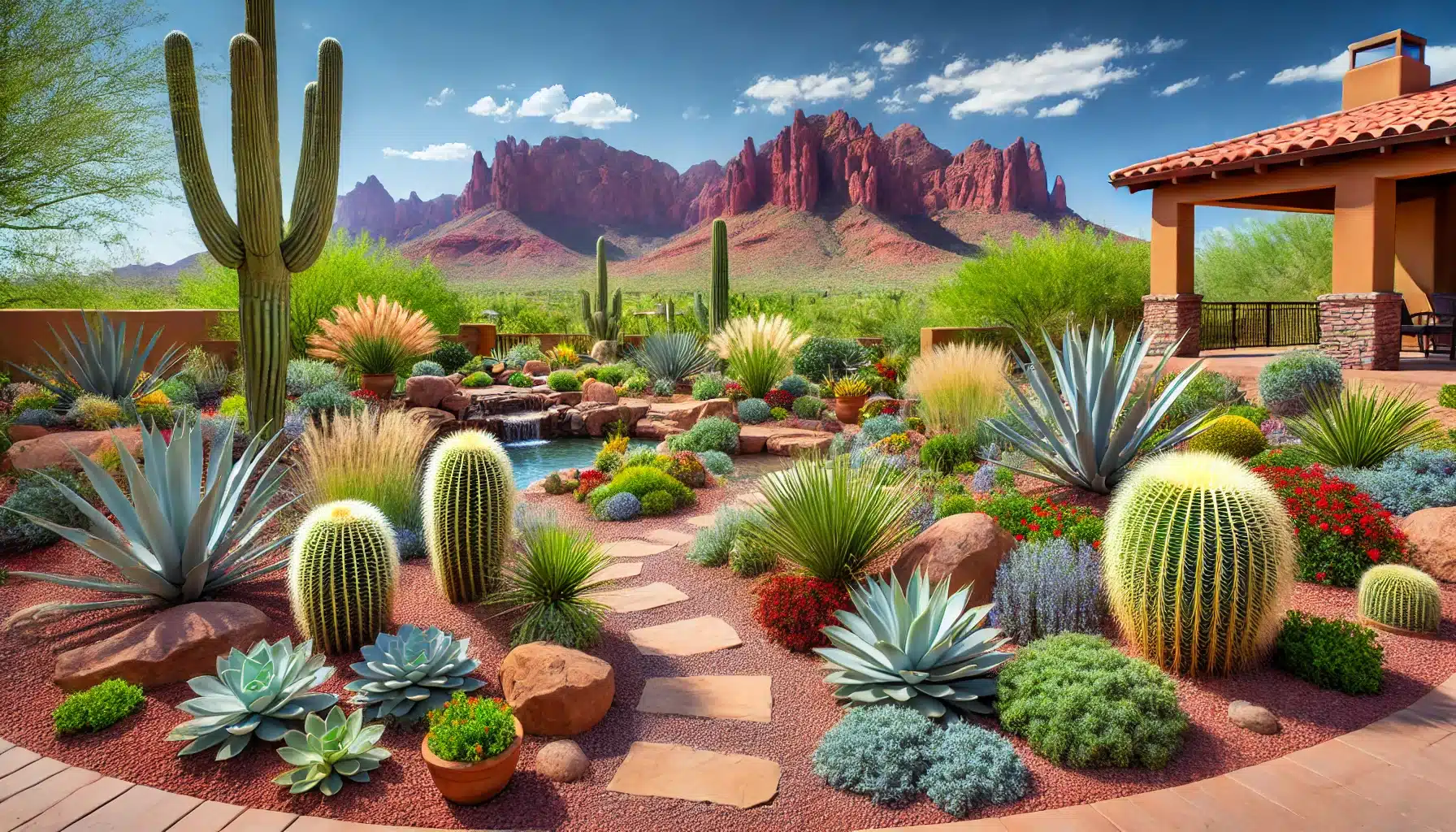Creating a beautiful and sustainable landscape in Arizona can be a rewarding experience. The unique climate and stunning natural beauty of the region offer endless possibilities for homeowners looking to enhance their outdoor spaces. Whether you’re new to gardening or looking to improve your existing landscape, these tips and tricks will help you achieve a lush, vibrant garden that thrives in the desert environment.
Contents
Understanding the Arizona Climate
Key Characteristics of Arizona’s Climate
Before diving into landscaping tips, it’s essential to understand the key characteristics of Arizona’s climate:
- Hot Summers: Temperatures often exceed 100°F.
- Mild Winters: Winters are mild, with occasional frost.
- Low Humidity: The air is typically dry, which affects plant selection.
- Limited Rainfall: Annual precipitation is low, making water conservation crucial.
Adapting to the Desert Environment
To successfully landscape in Arizona, it’s vital to adapt to the desert environment. This means selecting plants and materials that can withstand the heat, low humidity, and limited water supply.
Choosing the Right Plants
Native Plants
Native plants are an excellent choice for Arizona landscaping because they are adapted to the local climate and soil conditions. Here are some popular native plants:
- Saguaro Cactus: Iconic and drought-tolerant.
- Desert Marigold: Bright yellow flowers and minimal water needs.
- Red Yucca: Attractive red blooms and hardy nature.
Drought-Tolerant Plants
In addition to native plants, consider incorporating drought-tolerant varieties that can thrive with minimal water:
- Aloe Vera: Succulent with medicinal properties.
- Agave: Architectural plant with low water requirements.
- Lantana: Colorful flowers that attract pollinators.
Creating a Planting Plan
When planning your garden, group plants with similar water and sunlight needs together. This approach, known as hydrozoning, ensures efficient water use and healthier plants.
Soil Preparation and Mulching
Improving Soil Quality
Arizona’s soil can be challenging for gardeners due to its high clay content and low organic matter. To improve soil quality:
- Add Organic Matter: Incorporate compost to enhance soil structure and fertility.
- Use Raised Beds: Raised beds can improve drainage and make soil amendments easier.
Benefits of Mulching
Mulching is essential in Arizona landscapes for several reasons:
- Conserves Moisture: Reduces evaporation and keeps roots cool.
- Suppresses Weeds: Minimizes weed growth.
- Improves Soil Health: Adds organic matter as it decomposes.
Use organic mulches like wood chips or bark, and apply a 2-3 inch layer around plants, keeping mulch away from plant stems to prevent rot.
Efficient Irrigation Techniques
Drip Irrigation Systems
Drip irrigation is highly effective for Arizona gardens because it delivers water directly to the plant roots, reducing evaporation and water waste. Benefits include:
- Water Efficiency: Minimizes water loss.
- Targeted Watering: Ensures plants receive adequate moisture.
- Reduced Weed Growth: Keeps soil surface drier.
Watering Schedule
Establishing a proper watering schedule is crucial. Water deeply and infrequently to encourage deep root growth. Early morning or late evening watering is best to reduce evaporation.
Rainwater Harvesting
Consider installing a rainwater harvesting system to collect and store rainwater for your garden. This sustainable practice reduces reliance on municipal water supplies and provides a free source of water.
Incorporating Hardscaping Elements
Benefits of Hardscaping
Hardscaping elements like pathways, patios, and retaining walls can enhance your landscape’s functionality and aesthetics. Benefits include:
- Reduced Maintenance: Less time spent on upkeep.
- Water Conservation: Hardscaping reduces the need for irrigation.
- Visual Appeal: Adds structure and interest to your garden.
Popular Hardscaping Materials
Choose materials that complement the natural environment and withstand Arizona’s climate:
- Flagstone: Durable and visually appealing.
- Gravel: Low-maintenance and versatile.
- Pavers: Available in various styles and colors.
Creating Shade and Shelter
Importance of Shade
Shade is essential in Arizona landscapes to protect plants and provide comfortable outdoor spaces. Benefits of incorporating shade include:
- Reduced Water Needs: Shaded areas require less water.
- Lower Temperatures: Cooler areas for plants and people.
- Extended Plant Lifespan: Protects plants from harsh sunlight.
Shade Structures
Consider adding shade structures like pergolas, arbors, or shade sails to your garden. These structures can be both functional and decorative, providing relief from the sun while enhancing the visual appeal of your landscape.
Using Trees for Shade
Planting trees is another effective way to create shade. Select drought-tolerant tree species like Mesquite, Palo Verde, or Desert Willow. Place trees strategically to provide shade for outdoor living areas and garden beds.
Attracting Wildlife
Benefits of a Wildlife-Friendly Garden
Creating a garden that attracts wildlife can enhance biodiversity and add to the enjoyment of your outdoor space. Benefits include:
- Pollination: Attracting pollinators like bees and butterflies.
- Pest Control: Birds and beneficial insects can help control pests.
- Natural Beauty: Watching wildlife adds interest and joy to your garden.
Tips for Attracting Wildlife
To create a wildlife-friendly garden, consider the following tips:
- Plant Native Species: Native plants provide food and habitat for local wildlife.
- Provide Water Sources: Install birdbaths or small ponds.
- Create Shelter: Include shrubs, trees, and nesting boxes.
Sustainable Landscaping Practices
Xeriscaping
Xeriscaping is a landscaping method that focuses on water conservation through the use of drought-tolerant plants and efficient irrigation techniques. Principles of xeriscaping include:
- Soil Improvement: Enhance soil with organic matter.
- Efficient Irrigation: Use drip systems and water-saving technologies.
- Mulching: Apply mulch to retain moisture.
Composting
Composting is an excellent way to recycle garden waste and improve soil fertility. Benefits of composting include:
- Soil Enrichment: Adds essential nutrients to the soil.
- Waste Reduction: Reduces the amount of garden waste sent to landfills.
- Healthy Plants: Promotes vigorous plant growth.
Maintenance Tips
Seasonal Tasks
Regular maintenance is essential to keep your garden thriving. Here are some seasonal tasks to consider:
- Spring: Plant new annuals, prune shrubs, and clean up garden beds.
- Summer: Monitor irrigation, mulch, and protect plants from heat.
- Fall: Plant perennials, clean up fallen leaves, and prepare for winter.
- Winter: Prune trees, protect sensitive plants from frost, and plan for the next growing season.
Pest Management
Effective pest management is crucial for a healthy garden. Tips for managing pests include:
- Identify Pests: Learn to recognize common garden pests.
- Use Natural Predators: Encourage beneficial insects like ladybugs.
- Apply Organic Controls: Use organic pesticides and repellents.
Conclusion
Creating a beautiful and sustainable landscape in Arizona is achievable with the right knowledge and planning. By understanding the climate, choosing appropriate plants, and implementing efficient irrigation and maintenance practices, you can enjoy a thriving garden that enhances your outdoor living space.
Ready to transform your yard into an Arizona oasis? Request a Free Quote from Red Mountain Landscaping today!




